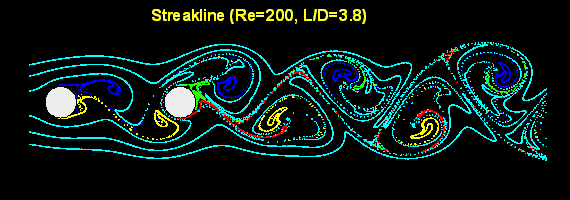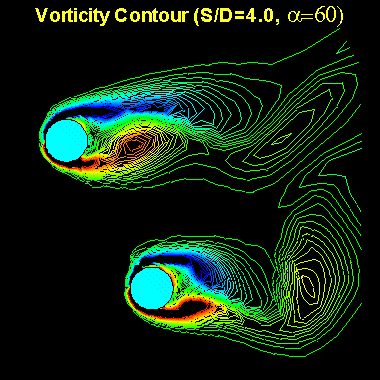Research Project

Mr.Zhao Jun
Fluid Division,
Department of Mechanical & Production Engineering
National University of Singapore, Singapore 119260
Flow structure visualization in multiply connected flow domain

(streakline distribution)
 Flow past two tandem cylinders
Flow past two tandem cylinders
 Flow past two transverse cylinders
Flow past two transverse cylinders
 Flow past two staggered cylinders
Flow past two staggered cylinders
Introduction
In an engineering environment, when a fluid flows past a group of bluff bodies or, equivalently, a group of bluff bodies moves in a fluid at rest, a region of disturbed flow is formed around the bodies. The extent of the disturbed flow region is largely dependent on the shape, orientation, size and the spacing among the bodies.
The dynamics of the flow field associated with multiple bluff bodies is rather complex. Due to the interaction of the wakes of the cylinders, the resulting dynamic properties including forces and vortex shedding frequency etc. can be significantly different from those found on a single body at the same Reynolds number.
Due to their practical relevance and importance, the study of the flow structure associated with either one or multiple bluff body(ies) has long been the interest of researchers. In order to better understand the flow structures involved, various flow visualization skills have been developed and used in scientific research. Experimental workers have applied various visualization skills including the dye/smoke methods [3] and Particle image velocimetry (PIV) to help understanding the flow structures. The numerical researchers, on the other hand, had developed various computational schemes to compute the flow field, and try to learn more about the flow through the plotting of streamlines, streaklines and vorticity contours etc.
Flow past two circular cylinders is a special and relatively more straight forward case of flow past multiple bluff bodies. In reference to the free stream direction, the arrangement of cylinders can be classified as tandem, transverse and staggered. Some earlier experimental results on the studies of flow around two circular cylinders with equal diameter in tandem, transverse and staggered arrangements have been discussed and reviewed by Zdravkovich (1977) [4]. Oertel (1991) [5] has also reviewed some relatively recent numerical and experimental investigations about the wake behind circular cylinders
 Please send me any
comments and suggestions that you might have.
Please send me any
comments and suggestions that you might have.
- I would especially appreciate information concerning the closing of links that I provide.

Mr.Zhao Jun
Fluid Division, Department of Mechanical & Production Engineering
National University of Singapore, Singapore 119260

(streakline distribution) |
|
Introduction
In an engineering environment, when a fluid flows past a group of bluff bodies or, equivalently, a group of bluff bodies moves in a fluid at rest, a region of disturbed flow is formed around the bodies. The extent of the disturbed flow region is largely dependent on the shape, orientation, size and the spacing among the bodies. The dynamics of the flow field associated with multiple bluff bodies is rather complex. Due to the interaction of the wakes of the cylinders, the resulting dynamic properties including forces and vortex shedding frequency etc. can be significantly different from those found on a single body at the same Reynolds number. Due to their practical relevance and importance, the study of the flow structure associated with either one or multiple bluff body(ies) has long been the interest of researchers. In order to better understand the flow structures involved, various flow visualization skills have been developed and used in scientific research. Experimental workers have applied various visualization skills including the dye/smoke methods [3] and Particle image velocimetry (PIV) to help understanding the flow structures. The numerical researchers, on the other hand, had developed various computational schemes to compute the flow field, and try to learn more about the flow through the plotting of streamlines, streaklines and vorticity contours etc. Flow past two circular cylinders is a special and relatively more straight forward case of flow past multiple bluff bodies. In reference to the free stream direction, the arrangement of cylinders can be classified as tandem, transverse and staggered. Some earlier experimental results on the studies of flow around two circular cylinders with equal diameter in tandem, transverse and staggered arrangements have been discussed and reviewed by Zdravkovich (1977) [4]. Oertel (1991) [5] has also reviewed some relatively recent numerical and experimental investigations about the wake behind circular cylinders |
 Please send me any
comments and suggestions that you might have.
Please send me any
comments and suggestions that you might have.